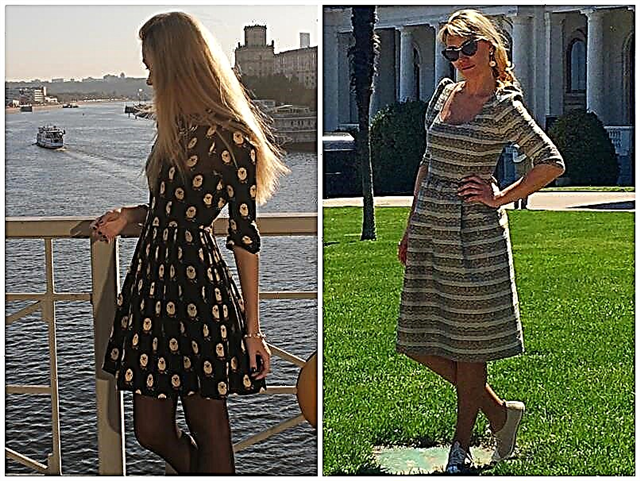The Hong Kong method most often processes allowances in lace products. Its essence is that the allowance of a part from lace is turned by a part from a lining fabric.

In this way, it is convenient to process parts with a direct cut or with a cut having smooth bends. But "obstacles" in the form of darts or lightning can create some inconvenience and delay the processing process.
Hong Kong slicing
In this master class, we will consider one of the options for processing stock allowances with tucks and a hidden zipper using the Hong Kong method using an example of a dress made of lace fabric.
Main tucks
You will need:
- tailor pins;
- ruler for marking allowances;
-special foot for stitching secret zippers;
- scissors, threads, needle.
Processing allowances for dress shelves with side (breast) tucks
Step 1. Cutting

Cut parts from lace and lining fabric: allowances of the part from the lace fabric - 1.5 cm, allowance of the part from the lining fabric - 3 cm.
Mark the tucks on the lace parts with the help of marking stitches. Do not bond layers of lace fabric and lining fabric together.
Step 2. Processing the bottom

On the details of the lining fabric, process the bottom: double bend with a width of 0.5 to 1.5 cm, sweep and iron.

Lay a stitch 1 mm from the fold, stitch width ~ 3 mm. Delete the note.
Step 3. Processing allowances

Place the part made of lining fabric on the part made of lace fabric so that both parts lie face up (the wrong side of the lining lies on the front side of the part made of lace), aligning the parts along the side cuts. Chipped with pins.
Note: an influx forms on the lining parts, this is correct.

Stitch the parts at a distance of 6 mm from the side sections, while the line starts below the tuck by about 2 cm.

Unscrew the part; now the wrong side of the lace part lies on the front side of the lining.
Spread the allowances so that the lining allowance goes around the part allowance from the lace. Secure with pins or sweep. Iron.

In the tuck area, the parts remain not finished.

Fasten allowances: sew a stitch in the seam. Stitch length ~ 3 mm.

Iron.
Step 4. Tuck Processing

In the area of tucks, securely fasten the top and lining details together: sweep or pin them off with pins.
To avoid excessive thickness, the depth of the tuck can be cut, do not forget to leave an allowance for grinding the tuck with a width of about 1 cm.

Chuck and sweep the tuck along the marked lines

Start tucking.

Iron tuck depth down.
Step 5. Final machining of allowances

The remaining unclosed stocking allowances should be twisted twice and pinned.

Hem allowances to be sewn by hand with hidden stitches.

Iron the treated area.
Note: WTO lace fabric must be done with caution, through a dense cotton iron pad. Pre-test the temperature regime on an unnecessary piece.

The front of the dress is ready.

So the treated area looks in the finished product.
Life hack: how to use a sheet of paper to lining stocks
Machining seam allowances with set-in countersunk zippers
The seam allowances of the blind zipper area are treated in the same way as the tuck area.
Step 1. Cutting
Cut back details: allowances of parts from lace fabric - 1.5 cm, allowance of parts from lining fabric - 3 cm.
Step 2. Processing the bottom
On the details of the lining fabric, process the bottom: double bend with a width of 0.5 to 1.5 cm, sweep and iron.
Lay a stitch 1 mm from the fold, stitch width ~ 3 mm. Delete the note.

This is how the underside of the bottom looks in the finished product.
Step 3. Processing allowances

Place parts from the lining fabric on the parts from the lace fabric so that all the parts lie face up (the wrong side of the lining lies on the front side of the lace part), aligning the parts along the side cuts. Chipped with pins.
Note: on the details of the lining, an influx forms, this is correct.
Start parts at a distance of 6 mm from the sections: sew along the side sections along the entire length of the section, grind along the back seam, starting about 2 cm below the zipper area.

Unscrew parts, now the wrong side of the lace part lies on the front side of the lining.
Spread the allowances so that the lining allowances bend around the lace allowances. Secure with pins or sweep. Iron.

In the area of lightning, parts remain unstacked.

Fasten allowances: sew a stitch in the seam. Stitch length ~ 3 mm.

Iron.
Step 4. Processing the hidden zipper

Lay marking stitches 1.5 cm from the cuts of lace parts, while fastening the lining and top parts together.

Stitch the back seam below the stitching area of the hidden zipper. Sweep away the place of stitching the secret zipper. Iron allowances.

The bottom of the zipper is treated with an inlay of lining fabric.

Place the zipper on the allowances face down and bind the tape of the zipper to the allowances.

Remove the rear seam mark in the zipper area.

Open the zipper and stitch it with the special foot.

Delete the note.
Step 5. Final machining of allowances

The remaining unclosed allowances for the lining should be twisted twice on the lightning tape and swept.

Hem allowances to be sewn by hand with hidden stitches. Iron.

The back of the dress is ready.

So the treated area looks in the finished product.

Good sewing!
The author of the master class and photo: Daria Tabatchikova

By education, Daria is a PR specialist and economist, but several years ago she devoted herself entirely to her favorite business - sewing.
She learned to sew from magazines, books and using the Internet, there are also sewing courses in the arsenal, but Daria considers herself to be self-taught. She loves to study specialized sewing literature from different years and countries, and then put her knowledge into practice.
At the end of 2017, Daria became the winner of the festive contest from BurdaStyle.ru.
She leads her Instagram page and VKontakte group.
Material prepared by Julia Dekanova



